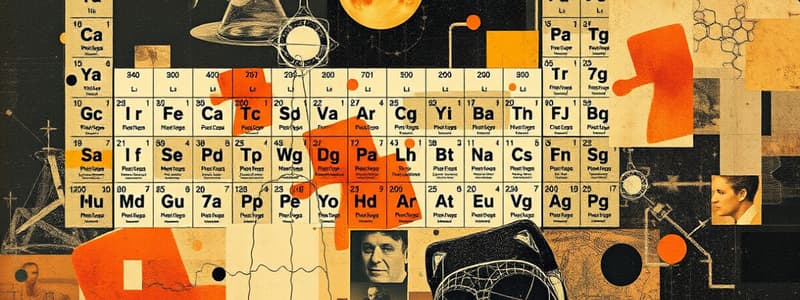Podcast
Questions and Answers
What does electron affinity measure in an atom?
What does electron affinity measure in an atom?
- The energy released when an atom gains an electron (correct)
- The number of electrons in an atom's outer shell
- The energy required to remove an electron
- The attraction between the nucleus and protons
How does atomic size tend to change within a group of the periodic table?
How does atomic size tend to change within a group of the periodic table?
- It increases with an increasing number of electron shells (correct)
- It increases due to increased ionization energy
- It decreases due to increased electron repulsion
- It remains constant regardless of the row
What is electronegativity related to in terms of an atom's behavior?
What is electronegativity related to in terms of an atom's behavior?
- The mass of the atom
- The ability to conduct electricity
- The ability to attract electrons (correct)
- The stability of the nucleus
Which statement accurately describes ionization energy?
Which statement accurately describes ionization energy?
What underlying factor explains the periodicity of chemical properties in the periodic table?
What underlying factor explains the periodicity of chemical properties in the periodic table?
What principle did Dobereiner's triads demonstrate about the elements he grouped?
What principle did Dobereiner's triads demonstrate about the elements he grouped?
What did Newlands' Law of Octaves propose about element properties?
What did Newlands' Law of Octaves propose about element properties?
How did Mendeleev contribute to the development of the periodic table?
How did Mendeleev contribute to the development of the periodic table?
What was the main assertion made by Henry Moseley regarding periodic trends?
What was the main assertion made by Henry Moseley regarding periodic trends?
Which statement accurately describes metals based on the modern periodic table?
Which statement accurately describes metals based on the modern periodic table?
Which group of elements does not conduct electricity?
Which group of elements does not conduct electricity?
What characteristic is NOT typical of metals?
What characteristic is NOT typical of metals?
What element is an exception to the general state of metals at room temperature?
What element is an exception to the general state of metals at room temperature?
Flashcards are hidden until you start studying
Study Notes
Periodic Trends
- Periodic Table structured by trends in chemical properties and electron configurations.
- Elements in the same column (group) share similar outer shell configurations.
Atomic Radius
- Atomic size is measured from the nucleus to the outermost electron shell.
- Atomic size increases down a group due to additional electron shells.
Electron Affinity
- Defined as the energy released when an atom gains an electron.
- Dependent on the attraction between the electron and the nucleus.
Ionization Energy
- Energy required to remove an electron from a gaseous atom.
- The farther an electron is from the nucleus, the easier it is to remove.
Electronegativity
- Measures an atom's ability to attract electrons.
- Linked to ionization energy and electron affinity, influencing the formation of cations and anions.
History of the Periodic Table
- John Dobereiner (1817) created triads of elements with similar properties, where the atomic weight of the middle element is the average of the other two.
- John Newlands (1866) proposed the Law of Octaves, noting that every eighth element shares properties with the first when arranged by increasing atomic mass.
- Dmitri Mendeleev (1869) related atomic weights to periodic property variations, forming the first periodic table.
- Henry Moseley (1894) refined the periodic law, stating that properties depend on atomic number, not atomic weight.
The Modern Periodic Table
- Metals are primarily solid (except mercury) at room temperature, are shiny, conductive, ductile, malleable, and commonly lose electrons in reactions.
- Nonmetals, primarily found on the right side of the table (excluding hydrogen), do not conduct electricity.
Studying That Suits You
Use AI to generate personalized quizzes and flashcards to suit your learning preferences.




